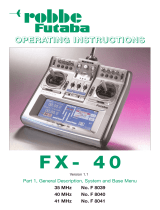
5
Building and Operating Instructions - Pilatus PC21 Nano-Racer No. 2599
Notes on the use of dry cells:
Do not attempt to recharge dry cells, do not open
them, and do not incinerate them. Remove exhausted
dry cells from the transmitter after use. Escaped elec-
trolyte may ruin the transmitter.
Ensure the equipment is protected from dust, dirt and moisture
contamination. Do not subject the system to excessive heat,
cold or vibration.
Use the recommended charger only, and charge the batteries
only for the prescribed period.
Check your equipment for damage at regular intervals, and
replace defective components with genuine spare parts.
Do not re-use any devices which have been damaged in a
crash or by water, even when they have dried out again.
Send the equipment to the robbe Service Department for
checking, or replace the parts in question.
Crash or water damage can result in concealed defects which
may lead to failure in subsequent use.
Use only those components and accessories which we spe-
cifically recommend.
Do not carry out modifications to the radio control system
components apart from those described in the instructions.
Operating the model
Caution - injury hazard:
Please keep your model aircraft a safe distance away
from yourself and others. Never fly over spectators,
other pilots or yourself. Manoeuvres should always be
flown facing away from the pilot and spectators.
•Never y over spectators or other pilots, and maintain a
safe distance from them at all times.
•Neverendangerpeopleoranimals.
•Neveryclosetohigh-tensionoverheadcablesorresiden-
tial areas.
•Donotoperateyourmodelinthevicinityofcanallocksor
open waterways.
•Donotoperateyourmodelfrompublicroads,motorways,
paths and squares etc.; use authorised model flying sites
only.
•Neveroperatethemodelinstormyweather.
Be sure to read these Safety Notes before you operate
your model. Always keep to the procedures and settings
recommended in the instructions.
If you are operating a radio-controlled model aircraft, he-
licopter, car or boat for the first time, we recommend that
you enlist an experienced modeller to help you.
Safety Notes
Radio-controlled models are not toys in the usual sense of the
term. Young persons under fourteen years should only be allo-
wed to operate them under the supervision of an adult.
Building and operating these models requires technical exper-
tise, manual skills, a careful attitude and safety-conscious be-
haviour.
Errors, negligence and omissions in building or flying these mo-
dels can result in serious personal injury and damage to pro-
perty.
Since the manufacturer and vendor are not in a position to check
that your models are built and operated correctly, all we can do
is bring these hazards expressly to your attention. We deny all
further liability.
Aircraft propellers, and all moving parts generally,
constitute a constant injury hazard. It is essential
to avoid touching such parts.
Please bear in mind that motors and speed con-
trollers may become hot when operating. It is es-
sential to avoid touching such parts.
Do not stand close to the hazard area around rotating
parts when an electric motor is connected to the flight
battery.
You must also take care to keep all other objects away
from moving or rotating parts.
Observe the instructions provided by the battery
manufacturer.
Overcharged or incorrectly charged batteries may ex-
plode. Take care to maintain correct polarity.
Never “point” the transmitter aerial straight at the model when
operating it. The transmitter signal is at its weakest in this
direction. It is always best to stand with the long side of the
aerial angled towards the model.
Insurance
Ground-based models are usually covered by standard per-
sonal third-party insurance policies. In order to fly model air-
craft you will need to extend the cover of your existing policy,
or take out specific insurance.
Check your insurance policy (private third-party) and
take out new cover where necessary.
Liability exclusion
robbe Modellsport is unable to ensure that you observe the
assembly and operating instructions, or the conditions and
methods used for installing, operating and maintaining the
model components.
For this reason we accept no liability for loss, damage or costs
which are due to the erroneous use and operation of our pro-
ducts, or are connected with such operation in any way.
Regardless of the legal argument employed, our obligation
to pay compensation is limited to the invoice value of tho-
se robbe products directly involved in the event in which the
damage occurred, unless otherwise prescribed by law. This
does not apply if the company is deemed to have unlimited
liability according to statutory regulation due to deliberate or
gross negligence.






